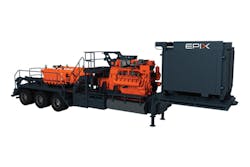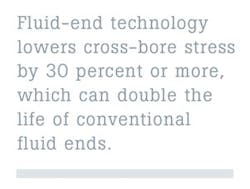Shutdowns during hydraulic fracturing are costly. Nonproductive time generated while troubleshooting impacts the bottom line and is an inefficient process. It is not uncommon to have an engine running smoothly while the pump is struggling to keep up, or vice versa.
Imagine a scenario where the engine, transmission, pump and controls are fully in sync. They are serviced and maintained as a complete unit with long-term production in mind through one trusted partner.
Uncommon in the oil and gas industry, the fully integrated, purpose-built power system for hydraulic fracturing now exists. The technology combines all power components along with the engine and pump, and they are designed to work together, even in the harshest environments. The system incorporates a powerful engine matched with a lightweight transmission, which drives the hydraulic fracturing pump. The result is one system that provides seamless operation with streamlined service through one company.
With an increased power output of 2,600 brake horsepower (bhp) (1,939 kilowatts), the engine provides more low-end torque, improved acceleration and expanded utilization of the frac pump’s performance, all of which provide maximum pressure and flow rate. The engine is available in a Tier 4-compliant model that does not require after-treatment processes. Lower emissions translates to better efficiency because the engine uses exhaust gas recirculation (EGR) emissions control technology. Combined with a refined, third-generation common rail injection system and two-stage turbocharging, it is reliable even in tough situations. Controlled, cooled exhaust gas recirculation means exhaust gas from a donor cylinder is fed into the EGR cooler and then returned to the cylinders. This lowers the combustion temperature, significantly reducing the production of harmful exhaust gases.
To ensure power is applied at the right place and time, the transmission offers eight gears with optimized gear ratios to minimize component stress and wear and results in a durable transmission with low life cycle costs. The design also ensures precise control of the pumping unit. The automatic transmission was designed and prepared for a power of 2,600 bhp and an input of up to 10,500 newton meters. Flexible coupling combined with the latest dampening technology prevents the transfer of engine vibrations throughout the drive system.
The industry’s first high-hp frac pump is designed for continuous-duty pressure pumping operations at a sustained 275,000-pound rod load, 24 hours per day, seven days per week. The pump incorporates a new dual-line optimized lubrication system, which regulates pressure and flow for each component, and onboard filtration to filter contaminants. The largest frac pump bearing in the industry evenly distributes stress on critical components, and the addition of an engineered skid and patent-pending improvements to the frame increase rigidity to resist cracking from increased rod loads and 24-hour operation. Fluid end technology lowers cross-bore stress by 30 percent or more, which can double the life of conventional fluid ends, and the use of corrosion-resistant stainless steel can deliver up to five times the fluid-end life.
This new pump was validated through extensive in-house testing as well as field testing in harsh, real-world conditions. The traditional frac pump development process typically tests around 1 million cycles at full-rod load. Completing a 13-million-cycle endurance test in-house, the new frac pump is designed to deliver durability, cost-efficiency, long-term performance and life span.
The pump recently logged more than 1,000 hours of field time in harsh conditions in the Duvernay and Montney formations in the Western Canada Sedimentary Basin. A scheduled inspection after the first 1,000 hours showed no sign of the typical wear seen in previous generation pumps, such as worn bearing gears, leaking seals or hoses, or broken bolts, to name a few. The pump is projected to meet 6,000 hours before any major overhaul, leading to the estimated reduction in total cost of ownership by 17 percent. The pump will return to the field for a minimum of 5,000 hours of additional testing.
Throughout the duration of the field testing, the pump experienced a maximum flow rate of 11.3 barrels per minute (1.8 cubic meters per minute [m3/m]) and a maximum pressure rate of 12,000 psi (not concurrent). The typical flow rate was 8.2 barrels per minute (1.3 m3/m), while typical pressure was 9,000 psi. During testing, the frac pump power system was situated behind a typical 2,500 bhp drive train and the pump used 100 percent of the available power and torque output.
Other independent research indicates operators using this type of pump have the potential to lower the capital intensity of pumping operations by more than 30 percent while achieving payback on investment within one to two years.
With these three components combined, the power system offers the most horsepower on the market. The engine is the only engine in the market rated for 2,600 bhp, and the pump is designed to take advantage of the engine’s full power capacity, lowering the number of units required on-site.
The combination of everything intelligently — not just mechanically and electronically — holds tremendous value from a production standpoint. The system is maintained and serviced under one contract, from one provider.
By synchronizing maintenance schedules with the engine and transmission, the pump is designed to reduce downtime and costs. All components are designed to work together to deliver more operating hours per unit. By allowing operators to align maintenance schedules and warranties across the entire power system, downtime is reduced and efficiencies are gained.
Future enhancements include incorporating intelligent systems for integrated monitoring and communication. Provided service warnings can help operators prevent costly or dangerous problems.
The current downturn has been a challenge for everyone in the industry. Furthermore, extracting resources in harsh conditions is never easy. Continuing innovation and forward thinking while many wait out the downturn produce a fully combined, seamless system to increase production and profitability when the rebound occurs.
Reference
1. Treadwell, S., & Wolters, D. (2016). "TD Drill Bit: Next-Generation Pumping Equipment on the Horizon," Industry Notes, TD Securities Inc., p. 5.
As manager of technical services for Weir Oil & Gas, Bill Jensen brings more than 40 years of oil field experience that enables him to create innovative solutions for Weir’s customers. He holds a Bachelor of Science degree from the University of Houston in Mechanical Engineering, Machine Design. In addition to managing Weir’s technical services, Jensen serves as a technical services engineer for EPIX. EPIX provides the industry’s first integrated system for hydraulic fracturing and is the result of a joint venture between Weir Oil & Gas and Rolls Royce Power Systems subsidiary MTU.





